 Glen Morris , Ontario  The Grand River used to be home to many Indian tribes that dotted the river in earlier days gone by, then the early pioneers moved in around the early 1800's and started to build mills on the banks of the river. Many of these mills were that of grinding mills for making flour and some others were built as woollen mills. Today there is a mill that is nestled in the woods by the Grand River near Glen Morris, Ontario that once had a flourishing business as a woollen mill, then as a summer retreat, and a private residence. 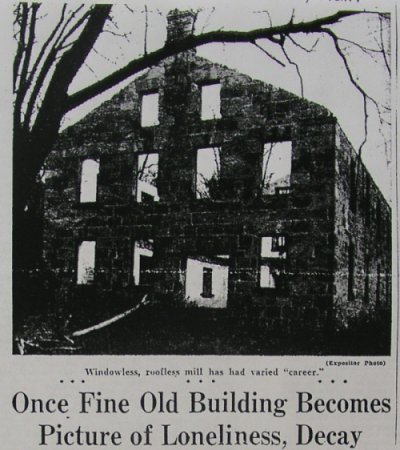 The Old German Mill that sits on the Grand River in the Southern part of Dumfries, Ontario has a vast history. There is a wealth of historical interest in the township of South Dumfries, Ontario as well as the Grand River itself. Similar to those of the Hudson Bay district and other North American Rivers. Glen Morris back in its day was known as Dawson's Bridge. It was named this, for this was where the first wooden bridge was built that crossed the Grand River. The village of Dawson's Bridge later to be known as Glen Morris was said to have been as rough and wild as any frontier town. History is very important in keeping the spirit alive of those who had played a small part in making our country great. Early settlers that came to our country many years ago had a dream to making life easier for everyone. The German family are one of the early settler families that played a small part into our country's history. The German family when they had arrived in South Dumfries purchased a lot of land at $1.50 an acre back in the year 1805 from William Dickson. Christopher I. German from Prince Edward County, had two sons, Peter and Lewis. Later on Peter German had a son named John Wesley German. Lewis German married Nancy McGee at Sophiasburg , Prince Edward County, March 18th 1804. Some five years later he moved to the vicinity of Stoney Creek Township of Salt fleet. They had four children of whom one was named George. George German was born May 7th 1805. It was in the year 1820 that Lewis German started out, heading for the township of South Dumfries, coming by way of Dundas and heading westward until he located a spring creek running by the foot of a hill, two miles west and one mile south of what is known today as St. George. Lewis had been gone from the family home for about seven days and his family became uneasy, fearing that he might have gotten lost in the woods or worse yet being devoured by a wild animal.The family had decided to send the eldest son George German to search for his father. Following his fathers tracks, George arrived at Troy where an uncle, Adam Misener, had a saw mill. Adam had told George that his father had continued west of Dumfries. George stayed the night at his uncle's place and continued his journey the next morning. Half way along the trail he found his father making his journey back home and the two of them returned home together. In the year 1820 the Lewis German family pulled up stakes and moved to South Dumfries and settled on lot 12 Con.1. It was then named German's Hollow. There were no roads at the time the German family moved into South Dumfries, only blazing trails through the woods. A small log house was erected on the east side of the road and a small stable by the creek. Under these conditions the family had carved a home by chopping down the trees and clearing the land to grow their wheat and potatoes. The wheat they had grown had to be taken to Dundas to be milled, a distance of some 20 miles. As the country became settled Governor's Road became the main road between Dundas and London. The mill was built in 1867 by Alva and Sydney German, which were relatives of Herbert German of St. George, Ontario. The Germans owned and operated another mill that used to be situated on the highway that ran between St. George and Brantford. Sydney had left the area after the mill was in operation for several years and sold his portion of the mill to his brother-in-law, James McCrea. Alva had stayed on, operating the mill after his brother had left. Alva German had built a house over looking the mill, on the highway that runs parallel to the mill. This is where he had raised his family and where his two daughters, named Dee German and Eliza German, were born. While the mill was in operation there was a terrible death that had occurred at the mill where a little girl had fallen into the raceway by the mill in the year 1886. Before she could be saved she was swept under the mill itself and drowned. The small rapids that rush by the old mill back in its day, and today, are still known as the Massasauga Rapids after the Indian tribe of that name, as pictured below. 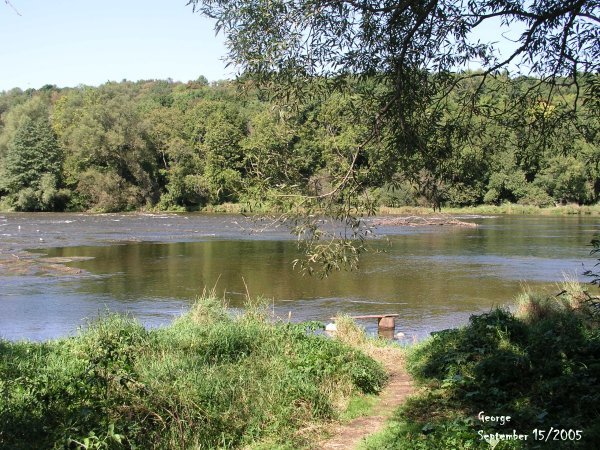 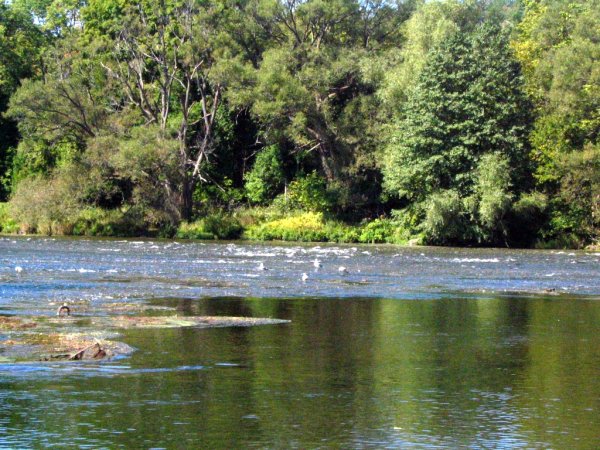 Some years later Alva had turned the mill over to James McCrea and his wife Nettie McCrea, after other and bigger mills started to spring up along the Grand River forcing the closure of the Old German Mill. Mrs. McCrea had the idea of making the old mill into a lodge and started fixing the mill up with the idea of making it into a sort of hotel. A considerable amount of money was spent in decorating and furnishing the mill. The idea that Mrs. McCrea had of making the old mill into a lodge was soon out lived for she had found over a few years that the idea of the hotel was not a very profitable investment. In the year 1941 there was a shooting death that had occurred at the lodge in one of the guests rooms. A Dan Hoover was murdered and to this day the murderer has never been found. On the edge of the Grand River about a mile or so east of Glen Morris in the year 1945 the local residence referred to the old German Mill as The Grand River Lodge. The lodge was entirely concealed from travelers on the highway known today as East River Road, which runs some 200 yards or so above and parallel to the lodge. The lodge itself was known to be in the glen of Glen Morris, Ontario. Mrs McCrea had then sold the lodge over to a gentleman named T. E. Robson, a resident of Brantford, Ontario, that was a manager of a book store called J. L. Sutherland in Brantford. Mr. Robson had purchased the lodge for the sum of $500.00. Mr. Robson then remodeled the lodge and re-furnished it with antiques. The lodge then was used as a summer residence. The Grand River Lodge formerly known as the Old German Mill, had 13 bedrooms, 2 dining rooms, another dining room that was a small private one, a large public room, as well as a large kitchen, with 4 washrooms. In the big public room within the old mill were two grand pianos that belonged to Mr. Tom Robson. Mr. Robson Enjoyed his new summer retreat until 1944 when he was notified by the Canadian Pacific Railway company that they were planing to build a rail line across the only roadway that lead to his summer resort. The railway company had purchased the right to close the roadway which was the only accessible entrance to the property from the main highway, over the proposed tracks, to the building. Mr. Robson had spent a lot of money with lawyers to have the roadway that lead to the old mill remain open. In the end Mr. Robson had lost his bid in court. Part of the old roadway that lead to the mill is still there and one can see the rail trail that crosses the roadway today. The township had offered to purchase the summer residence from Mr. Robson for the sum of $688.00. Mr. Robson accepted the proposal from the township to recover some of the money he had spent to purchase the old mill. In the end all he made off the property was less than $200.00 dollars more than what he had paid for it. 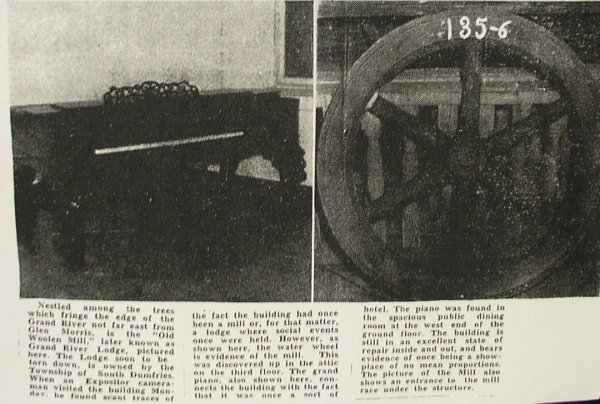 There was news that sprung up in September 1945 that the lodge was to be torn down.The lodge at this time was owned and operated by the township of South Dumfries. Somehow the mill escaped being torn down by the township for the mill still stands today at the edge of the Grand River. The township of South Dumfries was originally part of the lands that were granted to the Six Nations Indians by the British Crown at the end of the Revolutionary war. These grants to the six nations comprised some of the most fertile and picturesque country in the province. They were situated on the bay of Quinte, the Thames and the Grand Rivers with the later being the principal Reservation. On February 5th 1798, Chief Joseph Brant, sold to Philip Steadman what was known as Block 1, 94,305 acres of land. Which, by an act passed later in the Provincial Legislation, would become known as the Township of South Dumfries. The price the land was sold for was $8,841.When Mr. Steadman passed away in the year 1810, he did not leave a will. His sister Mrs. John Sparkman sold the Township in the year 1811, to a Thomas William Clarke, who in turn sold the land to a William Dickson on July 3rd 1816. The land was sold for $24,000 to Mr. Dickson. Today the mill still stands in ruin and is concealed from travelers that rush by along the busy road of East River Road in Glen Morris, Ontario. 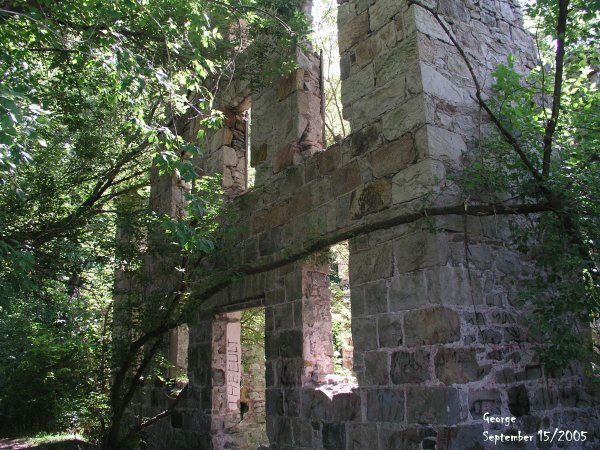 The mill that had a vast history stands today as a large deserted, roofless, ghostly looking building, that sits on the east bank of the Grand River near Glen Morris, Ontario. This is all that remains to remind residents in the area of the woollen mill that once prospered here. 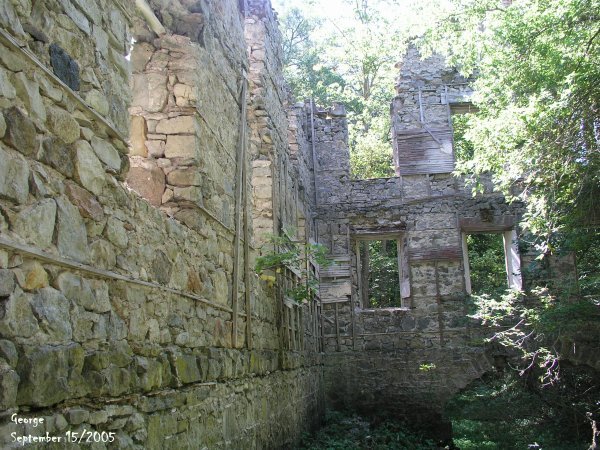 The mill in it's 138th year (1867-2005) still stands on the eastern bank of the Grand River. It shows little today of its former glory of a woollen mill, a flourishing tourist lodge or a private summer residence. Nothing stands but a shell of four stone walls that are about two and a half feet thick, that appears grim and forbidding to those that come upon the mill today. 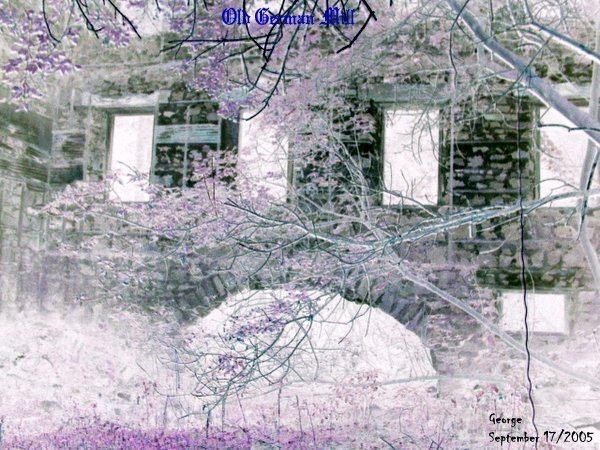 In this haunting looking photo you can see traces of the original raceway, which ran under the building, and can still be seen today. 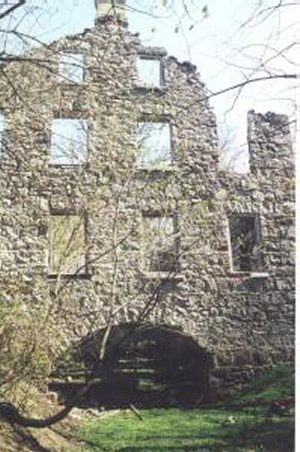 The overall size of the building is approximately 60 by 40 feet and during its later years was comprised of a wide hall, kitchen, and living room as well as two dining rooms on the main floor. Upstairs on the second floor there were 13 bedrooms. The third floor was the attic room of the mill.  Old German Mill History (1) Old German Mill History (2) September 17, 2005 (1) September 17, 2005 (2) September 25, 2005 (1) October 1, 2005 (1) October 1, 2005 (2) October 1, 2005 (3) October 1, 2005 (4)    |